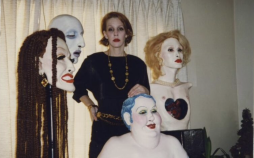Greer Lankton's Dolls: An Expression of the Self and the Bodies we Live in
/About Greer Lankton
IMAGE COURTESY OF WESA
Greer Lankton is a transgender visual artist who is well-known for her uncanny, eye-catching, handmade dolls. She was born in Flint Michigan in 1958 and died in 1996 as a result of an overdose. Lankton transitioned from male to female when she was 21 years old.
Lankton was interested in dolls from a young age, however as a child her parents were not supportive of this interest and did not allow her to have dolls. This sparked Lankton’s artistic aspirations as she began making puppets from various materials, such as socks and pipe cleaners.
As Lankton’s abilities, and her interest in art, grew, Lankton’s parents supported her artistic endeavors, though they were still uncomfortable with Lankton’s gender and sexuality. Lankton began studying in Brooklyn, New York, at the Pratt Institute in 1979.
In 1981, Lankton met Paul Monroe, the owner of a dress shop, at the Civilian Warfare gallery during Greer’s first independent show. Monroe was in awe of Lankton’s work and was intrigued by the doll’s glamour and haunting beauty.
In 1983, the two moved in together and by 1987 they got married. They divorced in 1993, though Monroe claims the divorce papers were forged by Lankton’s mother and that the two never actually divorced before Lankton’s passing.
Dolls as a Reflection of the Self
IMAGE COURTESY OF XTRA
Lankton’s art work often reflects the difficulties she faced during her transition and her struggles with drug use and anorexia. The dolls she created explore concepts of gender, body image and sexuality. She also used her art to challenge traditional gender norms and societal beauty standards.
Her dolls range from the size of regular dolls, to life-size versions. These dolls are occasionally based on real people, such as the iconic drag queen, Divine and other queer icons such as Candy Darling and Teri Toye.
Her work became more popular once she met her gallerist, who suggested she take photographs of the dolls. These photos are often of the dolls in different arrangements, sometimes Lankton herself is featured in these pictures as well.
The dolls were often made using whatever materials Lankton had around. Common items she would use included old t-shirts, paint, bottles, old umbrellas and anything else she could get her hands on. She would build these dolls up and dress them, finishing their look with glass eyes. Lankton felt that the dolls weren’t just creations, but extensions of our exteriors, and a statement about the “human condition”.
Greer Lankton’s Lasting Impact
IMAGE COURTESY OF THE MATTRESS FACTORY
Though Greer Lankton’s life was cut short, her impact is still far-reaching. Over her lifetime, Lankton made over three hundred dolls. That number becomes even larger if the dolls she remade are taken into account. The dolls that Lankton left behind are possessed by different institutions and people, such as the Mattress factory, David Newcomb, MoMA, Monroe and various other private collectors. In this way, Lankton remains an extremely relevant part of queer art and culture.
While Lankton was alive, she found community in a place called the Mudd Club, where she came into contact with other queer artists and stars. This community was the inspiration for many of her dolls, which were often displayed in the windows of Monroe’s dress store called Einsteins.
Lankton’s unique dolls, and interesting photographs continue to inspire conversations about gender and sexuality. Her art captures the beauty, and the horrors of having a body, reflecting societal and individual feelings about living in a body that experiences constant adversity and growth.
Jessica Fraser is a Professional Writing student at Algonquin College. She has also spent time studying English at Lakehead University and has taken many queer studies courses. She has written in a variety of different formats, such as poetry, short stories, essays, and research papers. She mainly writes fiction and the genres she focuses on are horror, sci-fi, and fantasy.





